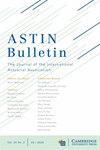以非寿险理赔发生与发展模式,弥合定价与预留之间的差距
IF 1.8
3区 经济学
Q2 ECONOMICS
引用次数: 3
摘要
摘要由于报告和结算延迟的存在,非寿险公司收集的索赔数据集通常是不完整的,面临着正确审查的索赔数量和索赔严重程度观察。目前非寿险定价的做法是通过两步程序来处理这些经过审查的数据。首先,使用不完整的历史索赔数据,计算过去暴露期间发生的索赔数量和最终索赔严重程度的最佳估计。其次,价格精算师建立预测模型,通过将这些最佳估计作为实际观察结果来估计新合同的技术纯溢价,从而忽略其固有的不确定性。我们提出了另一种方法,为非寿险定价和预留都带来了有价值的见解。因此,我们有效地将这两个传统上在孤岛中讨论的关键精算任务连接起来。在此,我们开发了一个非寿险索赔的颗粒状发生和发展模型,该模型解决了保留问题,同时解决了传统定价技术中实际观测值与估算最佳估计值之间的不一致。我们以保险和再保险组合为例说明我们提出的模型。我们提出的策略的优势在再保险案例中最引人注目,因为在最佳估计中,较大的不确定性源于长期的报告和结算延迟、低索赔频率和高(甚至极端)索赔规模。本文章由计算机程序翻译,如有差异,请以英文原文为准。
Bridging the gap between pricing and reserving with an occurrence and development model for non-life insurance claims
Abstract Due to the presence of reporting and settlement delay, claim data sets collected by non-life insurance companies are typically incomplete, facing right censored claim count and claim severity observations. Current practice in non-life insurance pricing tackles these right censored data via a two-step procedure. First, best estimates are computed for the number of claims that occurred in past exposure periods and the ultimate claim severities, using the incomplete, historical claim data. Second, pricing actuaries build predictive models to estimate technical, pure premiums for new contracts by treating these best estimates as actual observed outcomes, hereby neglecting their inherent uncertainty. We propose an alternative approach that brings valuable insights for both non-life pricing and reserving. As such, we effectively bridge these two key actuarial tasks that have traditionally been discussed in silos. Hereto, we develop a granular occurrence and development model for non-life claims that tackles reserving and at the same time resolves the inconsistency in traditional pricing techniques between actual observations and imputed best estimates. We illustrate our proposed model on an insurance as well as a reinsurance portfolio. The advantages of our proposed strategy are most compelling in the reinsurance illustration where large uncertainties in the best estimates originate from long reporting and settlement delays, low claim frequencies and heavy (even extreme) claim sizes.
求助全文
通过发布文献求助,成功后即可免费获取论文全文。
去求助
来源期刊

ASTIN Bulletin
数学-数学跨学科应用
CiteScore
3.20
自引率
5.30%
发文量
24
审稿时长
>12 weeks
期刊介绍:
ASTIN Bulletin publishes papers that are relevant to any branch of actuarial science and insurance mathematics. Its papers are quantitative and scientific in nature, and draw on theory and methods developed in any branch of the mathematical sciences including actuarial mathematics, statistics, probability, financial mathematics and econometrics.
 求助内容:
求助内容: 应助结果提醒方式:
应助结果提醒方式:


